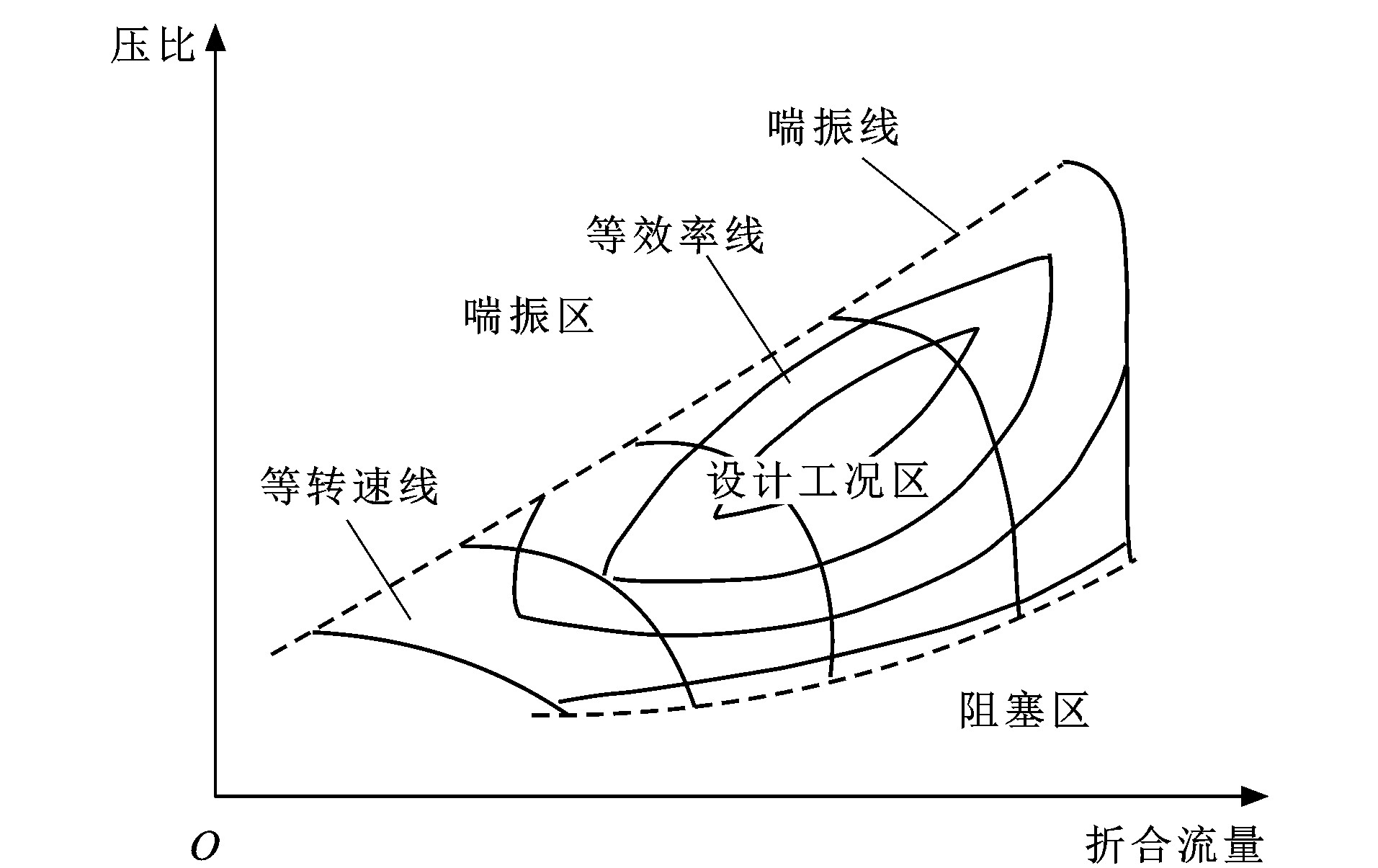Zonal modeling method for mass flow of large-scale marine compressor
-
摘要: 针对查表法外推能力不可靠以及采用单一曲线拟合法时在压气机不同工作区域的预测与外推精度不一致的问题, 提出了一种船用大型压气机质量流量分区域建模方法; 通过定义区域划分函数, 将压气机整个工作区域划分为设计工况区、低转速区、高转速区与低压比区, 通过对比与分析经典的和近年提出的压气机质量流量数学模型的预测和外推精度, 为每个区域选择精度最高的数学模型; 为防止在动态仿真过程中当压气机运行点由其他区进入低压比区时可能出现的不连续间断点, 应用一种曲线融合方法来保证等转速线的平滑过渡; 为验证所提出的建模方法的正确性与有效性, 将其应用于一台船用大型低速二冲程柴油机仿真模型中开展稳态与瞬态仿真试验。研究结果表明: 相比查表法, 提出的建模方法可有效提升主机仿真模型增压器转速的稳态预测精度, 平均绝对百分误差由3.54%下降至0.61%, 在改变主机转速与负载这2种瞬态工况下, 压气机的运行点可平稳、连续地由设计工况区过渡至非设计工况区; 提出的建模方法既能准确预测压气机设计工况区内的已有样本数据点, 又能合理、稳健地外推至非设计工况区, 既可直接应用于涡轮增压发动机的动态仿真研究中, 也可用于离线生成压气机在全工况范围内的性能图谱, 进而应用于商业发动机性能仿真软件中。Abstract: To address the problems of unreliability of extrapolation when using a look-up table and inconsistent accuracy in prediction and extrapolation when using a single curve-fitting method in different operating zones of a compressor, a zonal modeling method was proposed for the mass flow of a large-scale marine compressor. After a zone division function was defined, the entire operating area of compressor was divided into the design, low-speed, high-speed, and low-pressure ratio zones. Following a comparison and analysis of the accuracies of prediction and extrapolation with the classical and proposed compressor mass flow models, a mathematical model with the highest accuracy was selected for each zone. A curve blending method was adopted to guarantee a smooth transition of the iso-speed line to prevent the possible discontinuity when the operating point enters the low pressure ratio zone from other operating zones during the dynamic simulation process. To validate the correctness and effectiveness of the proposed modeling method, it was applied to the simulation experiment of a large-scale low-speed two-stroke marine diesel engine model conducted under steady and transient operating conditions. Research result shows that compared with the look-up table method, the proposed modeling method can effectively improve the steady-state prediction accuracy of turbocharger rotational speed for the main engine simulation model, while reducing the mean absolute percentage error from 3.54% to 0.61%. The operating point of compressor can transition steadily and continuously from the design operating zone to the non-design operating zones under the transient operating condition when the speed and load of main engine change. The proposed modeling method not only accurately predicts the existing sample data points in the design operating zone of compressor, it also reasonably and robustly extrapolates the data to the non-design operating zones. The method can be applied directly to dynamic simulation research of turbocharged engines, and can be used to generate the compressor performance map for the full range of operating conditions offline. Accordingly, the method can be used in commercial engine performance simulation software.
-
表 1 两类压气机叶片直径估算方法的预测误差
Table 1. Prediction errors of two estimation methods for compressor impeller diameter
型号 实际值/m 文献[19]中的方法 本文方法 估计值/m 误差/% 估计值/m 误差/% TCA88-25070 0.893 0 0.836 2 -6.36 0.886 4 -0.74 TCA55 0.500 0 0.468 2 -6.36 0.496 7 -0.66 表 2 A270-L59与TCA88-25070型船用大型压气机主要技术参数
Table 2. Main technical parameters of A270-L59 and TCA88-25070 large-scale marine compressors
型号 A270-L59 TCA88-25070 叶片直径/m 0.59 0.893 最大流量/(m3·s-1) 23 60 最大转速/(r·min-1) 16 800 11 763 样本点数 289 54 表 3 各压气机质量流量模型在设计工况区内的预测精度(A270-L59)
Table 3. Prediction accuracies of various compressor mass flow models in design operating zone (A270-L59)
模型名称 R E/% δ5%/% δ10%/% 管聪模型 0.999 6 0.56 100.00 100.00 Karlson-Ⅰ模型 0.998 9 1.00 98.96 99.65 Karlson-Ⅱ模型 0.998 9 0.91 99.31 100.00 Malkhede模型 0.990 5 3.20 82.00 97.92 Kolmanovsky模型 0.989 0 3.39 82.00 92.73 Müller-Ⅰ模型 0.986 4 2.13 89.27 98.96 Müller-Ⅱ模型 0.971 4 3.52 77.51 95.85 Leufvén-Llamas椭圆模型 0.913 3 6.81 77.85 84.78 表 4 各压气机质量流量模型在设计工况区内的预测精度(TCA88-25070)
Table 4. Prediction accuracies of various compressor mass flow models in design operating zone (TCA88-25070)
模型名称 R E/% δ5%/% δ10%/% 管聪模型 0.992 6 2.28 88.89 98.15 Karlson-Ⅰ模型 0.987 0 2.96 85.19 96.30 Karlson-Ⅱ模型 0.991 6 2.53 90.74 94.44 Malkhede模型 0.970 3 5.39 66.67 90.74 Kolmanovsky模型 0.961 8 6.76 57.41 75.93 Müller-Ⅰ模型 0.972 2 4.37 66.67 90.74 Müller-Ⅱ模型 0.945 6 6.28 51.85 83.33 Leufvén-Llamas椭圆模型 0.919 1 7.61 64.81 70.37 表 5 不同转速下Leufvén-Llamas椭圆模型与Karlson-Ⅰ模型阻塞流量的预测精度
Table 5. Prediction accuracies of choking flows by Leufvén-Llamas ellipse model and Karlson-Ⅰ model at different rotational speeds
模型名称 不同叶梢圆周速度下(m·s-1)的相对误差/% 550 525 500 475 450 400 350 300 250 Leufvén-Llamas椭圆模型 1.08 0.29 1.07 0.55 0.38 1.07 0.92 0.85 0.57 Karlson-Ⅰ模型 0.53 1.66 1.64 1.90 2.00 0.31 1.88 3.04 1.30 表 6 各压气机质量流量模型的LS区外推精度(A270-L59)
Table 6. Extrapolation accuracies of LS zone with various compressor mass flow models (A270-L59)
模型名称 管聪模型 Karlson-Ⅰ模型 Karlson-Ⅱ模型 Kolmanovsky模型 E/% 2.53 5.53 2.97 16.34 模型名称 Malkhede模型 Leufvén-Llamas椭圆模型 Müller-Ⅰ模型 Müller-Ⅱ模型 E/% 12.49 38.53 1.60 3.07 表 7 各压气机质量流量模型的LS区外推精度(TCA88-25070)
Table 7. Extrapolation accuracies of LS zone with various compressor mass flow models (TCA88-25070)
模型名称 管聪模型 Karlson-Ⅰ模型 Karlson-Ⅰ模型 Kolmanovsky模型 E/% 5.45 14.06 16.08 44.41 模型名称 Malkhede模型 Leufvén-Llamas椭圆模型 Müller-Ⅰ模型 Müller-Ⅱ模型 E/% 13.77 23.36 3.51 8.90 表 8 各压气机质量流量模型的HS区外推精度(A270-L59)
Table 8. Extrapolation accuracies of HS zone with various compressor mass flow models (A270-L59)
模型名称 管聪模型 Karlson-Ⅰ模型 Karlson-Ⅱ模型 Kolmanovsky模型 E/% 28.73 2.57 1.01 7.68 模型名称 Malkhede模型 Leufvén-Llamas椭圆模型 Müller-Ⅰ模型 Müller-Ⅱ模型 E/% 4.73 32.47 5.76 6.94 表 9 各压气机质量流量模型的HS区外推精度(TCA88-25070)
Table 9. Extrapolation accuracies of HS zone with various compressor mass flow models (TCA88-25070)
模型名称 管聪模型 Karlson-Ⅰ模型 Karlson-Ⅱ模型 Kolmanovsky模型 E/% 17.58 4.97 2.28 7.85 模型名称 Malkhede模型 Leufvén-Llamas椭圆模型 Müller-Ⅰ模型 Müller-Ⅱ模型 E/% 5.58 40.43 5.16 8.47 表 10 各稳态负荷条件下增压器转速预测结果对比
Table 10. Comparison of prediction results for turbocharger rotational speed at various steady loading conditions
方法名称 不同稳态负荷(%)下的相对误差/% E/% 15 25 50 75 80 100 查表法[31] 13.250 -2.43 -0.98 -1.14 -2.08 -1.34 3.54 分区域建模法 -0.043 -0.55 1.69 0.14 0.74 0.49 0.61 -
[1] SONG Kang, UPADHYAY D, XIE Hui. A physics-based turbocharger model for automotive diesel engine control application[J]. Proceedings of the Institution of Mechanical Engineers, Part D: Journal of Automobile Engineering, 2019, 233(7): 1667-1686. doi: 10.1177/0954407018770569 [2] TABURRI M, CHIARA F, CANOVA M, et al. A model-based methodology to predict the compressor behavior for the simulation of turbocharged engines[J]. Proceedings of the Institution of Mechanical Engineers, Part D: Journal of Automobile Engineering, 2012, 226(4): 560-574. doi: 10.1177/0954407011420790 [3] 李先南, 黄立, 张文正, 等. 两级增压对船用柴油机性能影响的试验[J]. 内燃机学报, 2020, 38(2): 104-109. https://www.cnki.com.cn/Article/CJFDTOTAL-NRJX202002002.htmLI Xian-nan, HUANG Li, ZHANG Wen-zheng, et al. Experiment of the influence of two stage turbocharging on the performance of a marine diesel engine[J]. Transactions of CSICE, 2020, 38(2): 104-109. (in Chinese). https://www.cnki.com.cn/Article/CJFDTOTAL-NRJX202002002.htm [4] LLAMAS X, ERIKSSON L. Parameterizing compact and extensible compressor models using orthogonal distance minimization[J]. Journal of Engineering for Gas Turbines and Power, 2016, 139(1): 012601. [5] 沈浩生, 张均东, 杨柏丞, 等. 一种考虑传热现象的船用压气机等熵效率分区域建模方法[J]. 船舶工程, 2020, 42(7): 76-87. https://www.cnki.com.cn/Article/CJFDTOTAL-CANB202007021.htmSHEN Hao-sheng, ZHANG Jun-dong, YANG Bai-cheng, et al. A zonal modeling approach of marine compressor isentropic efficiency with consideration of heat transfer phenomenon[J]. Ship Engineering, 2020, 42(7): 76-87. (in Chinese). https://www.cnki.com.cn/Article/CJFDTOTAL-CANB202007021.htm [6] 涂环. 大型船舶柴油机推进系统建模及转速控制研究[D]. 武汉: 武汉理工大学, 2015.TU Huan. Investigation on the modelling and speed control of marine diesel engine propulsion system[D]. Wuhan: Wuhan University of Technology, 2015. (in Chinese). [7] MORAAL P, KOLMANOVSKY I. Turbocharger modeling for automotive control applications[J]. SAE Technical Papers, 1999, DOI: 10.4271/1999-01-0908. [8] GHOLAMREZAEI M, GHORBANIAN K. Compressor map generation using a feed-forward neural network and rig data[J]. Proceedings of the Institution of Mechanical Engineers, Part A: Journal of Power and Energy, 2010, 224(1): 97-108. doi: 10.1243/09576509JPE792 [9] 管聪. 大型船舶降速航行主机性能优化方法研究[D]. 武汉: 武汉理工大学, 2015.GUAN Cong. Investigation on the performance optimisation method for large containership propulsion engine at slow steaming conditions[D]. Wuhan: Wuhan University of Technology, 2015. (in Chinese). [10] JENSEN J P, KRISTENSEN A F, SORENSON S C, et al. Mean value modeling of a small turbocharged diesel engine[J]. SAE Technical Papers, 1991, DOI: 10.4271/910070. [11] ERIKSSON L. Modeling and control of turbocharged SI and DI engines[J]. Oil and Gas Science and Technology, 2007, 62(4): 523-538. doi: 10.2516/ogst:2007042 [12] DOWELL P G, AKEHURST S. Advanced mapping techniques for radial compressor for use in real-time engine models[J]. SAE Technical Papers, 2010, DOI: 10.4271/2010-01-1227. [13] HADEF J E, COLIN G, CHAMAILLARD Y, et al. Physical-based algorithms for interpolation and extrapolation of turbocharger data maps[J]. SAE International Journal of Engines, 2012, 5(2): 363-378. doi: 10.4271/2012-01-0434 [14] MARTIN G, TALON V. Implementing turbomachinery physics into data map-based turbocharger models[J]. SAE International Journal of Engines, 2009, 2(1): 211-229. doi: 10.4271/2009-01-0310 [15] MALKHEDE D N, SETH B, DHARIWAL H C. Mean value model and control of a marine turbocharged diesel engine[J]. SAE Technical Papers, 2005, DOI: 10.4271/2005-01-3889. [16] KARLSON A T. On modeling of a ship propulsion system for control purposes[D]. Trondheim: Norwegian University of Science and Technology, 2012. [17] DINESCU D C, TAZEROUT M. Mean value modeling of a variable nozzle turbocharger (VNT)[J]. UPB Scientific Bulletin, Series D: Mechanical Engineering, 2010, 72(1): 109-116. [18] ZENG Tao, UPADHYAY D, ZHU Guo-ming. A reduced complexity model for the compressor power of an automotive turbocharger[J]. Journal of Dynamic Systems, Measurement and Control, 2018, 140(6): 061018. doi: 10.1115/1.4039285 [19] ERIKSSON L, NEZHADALI V, ANDERSSON C. Compressor flow extrapolation and library design for the modelica vehicle propulsion library-vehprolib[J]. SAE Technical Papers, 2016, DOI: 10.4271/2016-01-1037. [20] MÜLLER M, HENDRICKS E, SORENSON S C. Mean value modeling of turbocharged spark ignition engines[J]. SAE Technical Papers, 1998, DOI: 10.4271/980784. [21] LEUFVÉN O, ERIKSSON L. A surge and choke capable compressor flow model-validation and extrapolation capability[J]. Control Engineering Practice, 2013, 21(12): 1871-1883. doi: 10.1016/j.conengprac.2013.07.005 [22] LEUFVÉN O, ERIKSSON L. Measurement, analysis and modeling of centrifugal compressor flow for low pressure ratios[J]. International Journal of Engine Research, 2014, 17(2): 153-168. [23] LLAMAS X, ERIKSSON L. Control-oriented compressor model with adiabatic efficiency extrapolation[J]. SAE International Journal of Engines, 2017, 10(4): 1903-1916. doi: 10.4271/2017-01-1032 [24] ORIKISZ M, STAWARS S. Modeling of turbine engine axial-flow compressor and turbine characteristics[J]. Journal of Propulsion and Power, 2000, 16(2): 336-339. doi: 10.2514/2.5574 [25] ANDERSSON P. Air charge estimation in turbocharged spark ignition engines[D]. Linköping: Linköping University, 2005. [26] BITEUS J. Mean value engine model of a heavy duty diesel engine[D]. Linköping: Linköping University, 2004. [27] GUZZELLA L, AMSTUTZ A. Control of diesel engines[J]. IEEE Control Systems Magazine, 1998, 18(5): 53-71. doi: 10.1109/37.722253 [28] SIEROS G, STAMATIS A, MATHIOUDAKIS K. Jet engine component maps for performance modeling and diagnosis[J]. Journal of Propulsion and Power, 1997, 13(5): 665-674. doi: 10.2514/2.5218 [29] FANG Xian-de, CHEN Wei-wei, ZHOU Zhan-ru, et al. Empirical models for efficiency and mass flow rate of centrifugal compressors[J]. International Journal of Refrigeration, 2014, 41: 190-199. doi: 10.1016/j.ijrefrig.2014.03.005 [30] YANG Bei, FANG Xian-de, ZHANG Li-sheng, et al. Applicability of empirical models of isentropic efficiency and mass flow rate of dynamic compressors to jet engines[J]. Progress in Aerospace Sciences, 2019, 106: 32-42. doi: 10.1016/j.paerosci.2019.01.007 [31] TANG Yuan-yuan, ZHANG Jun-dong, GAN Hui-bing, et al. Development of a real-time two-stroke marine diesel engine model with in-cylinder pressure prediction capability[J]. Applied Energy, 2017, 197: 55-70. -





 下载:
下载:




















